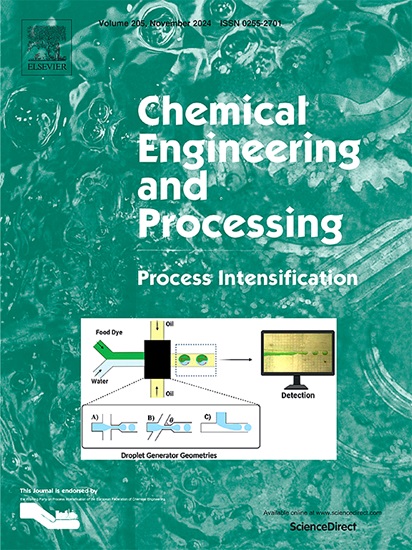Kinetic-embedded CFD modeling of integrated steam methane reforming and limestone calcination in a fluidized bed reactor
IF 3.8
3区 工程技术
Q3 ENERGY & FUELS
Chemical Engineering and Processing - Process Intensification
Pub Date : 2025-01-22
DOI:10.1016/j.cep.2025.110190
引用次数: 0
Abstract
The combination of limestone calcination, catalytic methane reforming, and combustion in one reactor (MRC![]() CAL) was previously proposed to achieve autothermal and hydrogen-producing sorbent regeneration for calcium-looping technology. However, this technology was only assessed using kinetic-only simulations. To further evaluate its viability, the present study developed an Eulerian-Eulerian CFD model with full reaction kinetics in a bubbling fluidized bed reactor. Three different operating parameters were studied: the inlet gas velocity, the sorbent to catalyst ratio, and the sorbent calcination extent. CFD simulations demonstrated that increasing the inlet gas velocity increased the H2 production by altering the particle distribution through the bed. Decreasing the catalyst-to-sorbent ratio improved local mixing whereas the catalyst tended to locate at the bottom of the bed where an increased total solid holdup was also found. Sorbents with higher calcination extent led to a decreased CO2 composition in the off-gas whilst increasing the H2 composition. When compared with kinetic-only simulations of a continuous reactor, the CFD results showed a noticeable discrepancy in the gas compositions mainly due to the free gas expansion and the more rigorous calculation of the particle mixing patterns, which were not included in the kinetic simulations. The sharp differences emphasized the importance of hydrodynamics in developing novel processes.
CAL) was previously proposed to achieve autothermal and hydrogen-producing sorbent regeneration for calcium-looping technology. However, this technology was only assessed using kinetic-only simulations. To further evaluate its viability, the present study developed an Eulerian-Eulerian CFD model with full reaction kinetics in a bubbling fluidized bed reactor. Three different operating parameters were studied: the inlet gas velocity, the sorbent to catalyst ratio, and the sorbent calcination extent. CFD simulations demonstrated that increasing the inlet gas velocity increased the H2 production by altering the particle distribution through the bed. Decreasing the catalyst-to-sorbent ratio improved local mixing whereas the catalyst tended to locate at the bottom of the bed where an increased total solid holdup was also found. Sorbents with higher calcination extent led to a decreased CO2 composition in the off-gas whilst increasing the H2 composition. When compared with kinetic-only simulations of a continuous reactor, the CFD results showed a noticeable discrepancy in the gas compositions mainly due to the free gas expansion and the more rigorous calculation of the particle mixing patterns, which were not included in the kinetic simulations. The sharp differences emphasized the importance of hydrodynamics in developing novel processes.

求助全文
约1分钟内获得全文
求助全文
来源期刊
CiteScore
7.80
自引率
9.30%
发文量
408
审稿时长
49 days
期刊介绍:
Chemical Engineering and Processing: Process Intensification is intended for practicing researchers in industry and academia, working in the field of Process Engineering and related to the subject of Process Intensification.Articles published in the Journal demonstrate how novel discoveries, developments and theories in the field of Process Engineering and in particular Process Intensification may be used for analysis and design of innovative equipment and processing methods with substantially improved sustainability, efficiency and environmental performance.

 求助内容:
求助内容: 应助结果提醒方式:
应助结果提醒方式:


